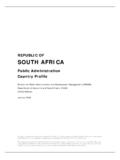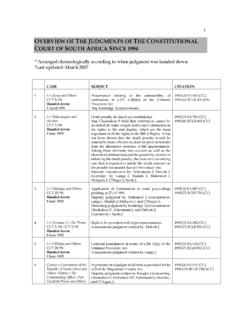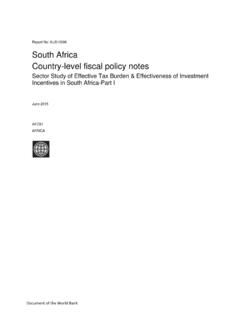Transcription of South African Common and Customary Law of …
1 South African Common and Customary Law of Intestate Succession: A Question of Harmonisation, Integration or Abolition Christa Rautenbach *. Readers are reminded that this work is protected by copyright. While they are free to use the ideas expressed in it, they may not copy, distribute or publish the work or part of it, in any form, printed, electronic or otherwise, except for reasonable quoting, clearly indicating the source. Readers are permitted to make copies, electronically or printed, for personal and classroom use. I. INTRODUCTORY REMARKS: THE CONTEXT ..2. II. COMMENTS ON THE DEVELOPMENT OF THE Customary LAW OF. SUCCESSION ..6. A. HARMONISATION, INTEGRATION AND UNIFICATION ..6. B. INDIRECT INTERVENTION OF THE JUDICIARY ..6. C. DIRECT INTERVENTION OF THE LEGISLATOR ..10. III. CONCLUDING REMARKS: POTJIEKOS ..13. It is no secret that colonialism had a considerable impact on the existence and development of law in South africa .
2 Modern South African law consists of a conglomeration of so-called transplanted laws made up of a mixture of Roman-Dutch law and English Common law, as well as indigenous laws, referred to as Customary law. In spite of Customary law being the law of the original inhabitants of this country, there has never been parity between the transplanted laws and the indigenous laws. Customary law was initially ignored by the colonials, then tolerated and eventually recognised, albeit with certain reservations and conditions. The situation did not change much over the years until the Constitution of the Republic of South africa , 1996, finally brought Customary law on a par with the Common law of South africa by affording it constitutional recognition, but subject to the Constitution and other legislation. Customary law of succession is one area of Customary law which has received considerable attention from the legal arena because of its distinctive patriarchal characteristics such as the rule of male primogeniture.
3 Over the years, the rule of male primogeniture survived numerous attacks from scholarly writers and the judiciary when it finally came under the spotlight in the Constitutional Court in Bhe v Magistrate, Khayelitsha * Professor of Law, North-West University (Potchefstroom Campus), South africa . Sections of the research on which this article is based, were made possible by the financial support of the National Research Foundation. However, the author takes full responsibility for any possible errors and opinions. This paper is appearing in the Journal of Comparative Law (JCL, ISSN 1477-0814) and is published in the EJCL with the permission of the JCL Editorial Board. 1. Electronic Journal of Comparative Law, vol. (May 2008), (Commission for Gender Equality as Amicus Curiae); Shibi v Sithole; South African Human Rights Commission v President of the Republic of South africa 2005 1 SA 580 (CC) where it was struck down as being unconstitutional.
4 In the presentation at hand I shall make a few remarks on the legal reform of the Customary law of succession in South africa . This will be done in the context of and with comparison to the South African Common law (Roman-Dutch law). I shall conclude the discussion with a few remarks on the influence of the Common and constitutional law on Customary law with a view to the future of Customary law of succession (in its current form) in a mixed legal system such as that of South africa . I. INTRODUCTORY REMARKS: THE CONTEXT. It is no secret that colonialism had a considerable impact on the existence and development of law in South africa . Modern South African law comprises a conglomeration of so-called transplanted laws made up of a mixture of Roman-Dutch law and English Common law, 1 as well as indigenous laws, referred to as Customary law. 2. In spite of Customary law being the law of the original inhabitants of this country, 3 there has never been parity between the transplanted laws and the indigenous laws.
5 During the First Worldwide Congress on Mixed Jurisdictions in 2002, Visser commented as follows: 4. [ Customary law] has always been treated as a stepchild in the South African legal order and this has obviously disadvantaged the many people who substantively live in accordance with autochthonous law for certain or all purposes. The unequal relationship between the transplanted and indigenous laws began in 1652 when the Dutch East India Company established a refreshment station in the Cape. As a result of the Dutch colonisation of the Cape, the law applicable to the settlers was Roman-Dutch law, 1. One of the features of the South African legal system is the fact that it is largely uncodified. Every lawyer knows that he or she has to consult various sources to find the law. These sources include legislation, precedent, Roman-Dutch law, custom, Customary law, modern legal textbooks and the Constitution. According to Girvin, The Architects of the Mixed Legal System, in SOUTHERN CROSS: CIVIL AND Common LAW IN South .
6 africa 95 (R. Zimmermann & D. Visser eds., 1996 Kenwyn) the mixed legal system in South africa owes a great deal to the earlier judges of South africa . 2. In terms of the Recognition of Customary Marriages Act 120 of 1988 Customary law is defined as the customs and usages traditionally observed among the indigenous African people and in terms of the Black Administration Act 38 of 1927 the term Black includes any person who is a member of any aboriginal race or tribe of africa . The Law of Evidence Amendment Act 45 of 1988 defines indigenous law as the Black law or customs as applied by the Black tribes in the Republic or in territories which formerly formed part of the Republic and the South African Law Reform Commission defines Customary law as the various laws observed by communities indigenous to the country . Although Customary law and indigenous law are used as synonyms in South African law, the first is preferred, since it is also the expression used in the Constitution of the Republic of South africa , 1996 (hereinafter the Constitution ).
7 3. This statement is controversial, since the history books show us that the original inhabitants were Hottentots (Koi) and Bushmen (San). The other black people are immigrants from the north of africa (at least north of the Zambeziriver). They and the white immigrants (colonists) met; the whites moving east and north;. the blacks southwards. Both had part in eradicating the Bushmen and Hottentots. The blacks and whites were more or less simultaneous immigrants, each occupying their tract of land. They met and collided in the vicinity of the Kei- and Great Fishrivers. Later, when the whites immigrated inland, northwards over the Orangeriver and across the Drakensberg and the Vaalriver, they fought each other in numerous wars for a long time in order to gain supremacy and territory. For detailed discussions of the early history of South africa , see, MULLER, VYFHONDERD JAAR SUID-AFRIKAANSE GESKIEDENIS (Pretoria 1990).
8 4. D. Visser, Cultural Forces in the Making of Mixed Legal Systems, 13 TUL. L. R. 74 (2003-4). 2. Electronic Journal of Comparative Law, vol. (May 2008), which was the official law of the Netherlands at that stage. The Dutch government was confronted with the existence of indigenous people on Cape soil whose customs and usages were totally different from those it was accustomed to, but there is no evidence that any account was taken of these customs and usages. 5. It was only after the second British occupation, in 1806, that Customary law received some form of recognition. The British confirmed Roman-Dutch law as the basic law of the land 6. and followed a policy of non-interference with the customs and usages of indigenous people, provided that these customs and usages were not repugnant to public policy and the principles of natural justice. 7 During this time the various territories 8 regulated the application of Customary law by means of their own legislation.
9 9 In 1927, the various territorial laws were finally consolidated in the controversial Black Administration Act, 10 which used to provide (and to some extent still provides) for the management of the affairs of certain black persons. Although subject to severe criticism, portions of this Act are still in operation Section 11(1) of the Black Administration Act gave universal recognition to Customary law for the first time, although Customary law's application was limited to the Customary courts and special courts established to deal with matters between Natives involving questions of customs followed by Natives. 12 When the special courts were abolished in the eighties, this section was repealed by section 54A(1) of the Magistrate's Court Act 13 which extended the application of Customary law by any court where people from indigenous communities were involved. Section 54A(1), in turn, was repealed and section 1(1) of the Law of Evidence 5.
10 Van Niekerk, Legal Pluralism, in INTRODUCTION TO LEGAL PLURALISM IN South africa 6-7 ( Bekker, C. Rautenbach & Goolam eds., Durban 2006). 6. Under the 1806 Treaty of Capitulation, whereby the Netherlands ceded the Cape to Britain. See, Bennett, The Conflict of Laws, in INTRODUCTION TO LEGAL PLURALISM IN South africa 17 (Bekker, Rautenbach & Goolam eds., 2006). 7. There were four reasons why the English colonials partially recognised Customary law. These were: (a). economical considerations; (b) fear of discontent; (c) treaties with certain chieftains; and (d) the belief that English law was too progressive to apply to the indigenous communities. See, ALLOTT, NEW ESSAYS IN. African LAW 12-13 (London 1970); Olivier, Recognition of Customary Law, in THE LAW OF South . africa 12 Vol 32 ( Joubert et al eds., 2004 Durban); Bennett, African Land: A History of Dispossession, in SOUTHERN CROSS: CIVIL AND Common LAW IN South africa 67 (Zimmermann & Visser eds.)









